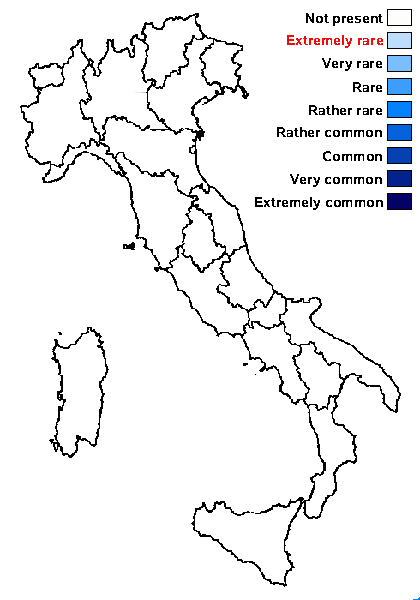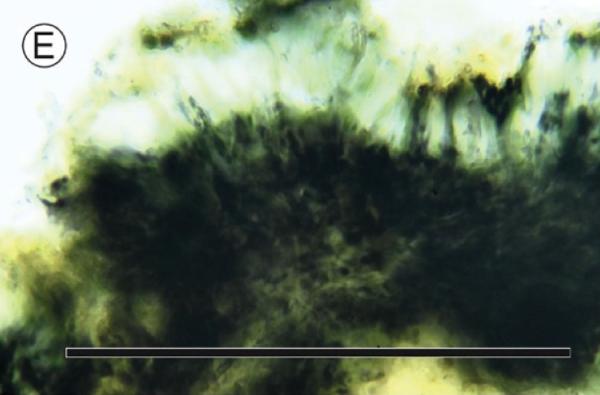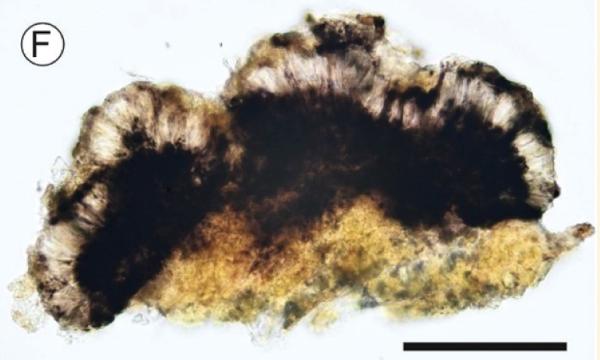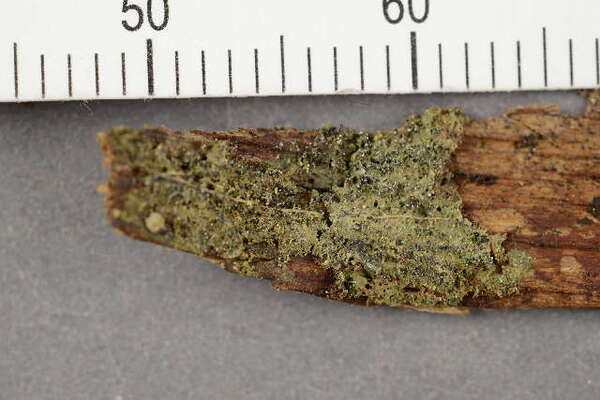Micarea nigella Coppins
Bull. Br. Mus. Nat. Hist., Bot. 11, 2: 163, 1983
Synonyms:
Distribution:
Description: Thallus crustose, endosubstratic or thinly episubstratic and film-like, whitish to pale grey-green, or inapparent. Apothecia micareoid, from the beginning subglobose, dull black, often confluent into tuberculate aggregates, 0.1-0.2 mm across (the aggregates up to 0.3 mm), without a distinct proper margin. Proper exciple mostly indistinct, sometimes evident in young apothecia as a dark narrow zone; epithecium scarcely differentiated from the hymenium, patchily purplish brown to olivaceous black, K+ dull blackish-green; hymenium colourless, often with vertical, purplish brown to dull olive-black streaks, 25-30 µm high; paraphyses scarce, of 2 types: a) evenly distributed, branched, hyaline, 0.7-1 µm thick, the apical cells up to 2 µm wide; b) scattered or gathered in small fascicles, mostly simple, stout, 2-3 µm thick, dark-pigmented throughout or at least in lower part; hypothecium mottled purple-black, dark purple-brown or sometimes with a dull olive-blackish tinge, 70-100(-160) µm high, K+ dark dull green, N+ purple-red. Asci 8-spored, clavate to cylindrical-clavate, in K/I with a blue outer layer and apical dome and unstained wall, the dome with an apical cushion, 20-28 x 8-11 μm. Ascospores 1-celled, hyaline, ovoid or oblong-ovoid, (5.7-)6.5-9.5(-12) x 2.5-4.2 µm. Pycnidia abundant, black, sessile to usually stalked, 60-300 µm tall (incl. stalk), 40-80 µm across, the ostioles often gaping and extruding a whitish mass of conidia, the walls dark green-black, but the lower part paler with ±purple tinge, K+ dull green and sometimes K+ purplish, N+ purple-red. Mesoconidia ellipsoid to short-cylindrical, often biguttulate, 3.4-4.3 x 1.2-1.6 µm. Photobiont micareoid, the cells 4-8 μm wide. Spot tests: thallus K-, C-, KC-, P-, UV-. Chemistry: thallus without lichen substances. Note: on wood, mostly in boreal-montane coniferous forests and in deeply shaded situations; widespread in Europe, with a single record from the Western Alps (Switzerland); to be looked for in the Italian Alps.
Growth form: Crustose
Substrata: lignum
Photobiont: green algae other than Trentepohlia
Reproductive strategy: mainly sexual, or asexual by conidia and thalloconidia

Predictive model

Source: Kantelinen A, Svensson M, Malíček J, Vondrák J, Thor G, Palice Z, Svoboda S, Myllys L (2024) A phylogenetic study of Micarea melaeniza and similar-looking species (Pilocarpaceae) unveils hidden diversity and clarifies species boundaries and reproduction modes. MycoKeys 106: 327-354. - CC BY-4.0
E–F Micarea nigella (Holotype) E apothecial section in K F apothecial section in water. Photo by A. Kantelinen

Source: Kantelinen A, Svensson M, Malíček J, Vondrák J, Thor G, Palice Z, Svoboda S, Myllys L (2024) A phylogenetic study of Micarea melaeniza and similar-looking species (Pilocarpaceae) unveils hidden diversity and clarifies species boundaries and reproduction modes. MycoKeys 106: 327-354. - CC BY-4.0
E–F Micarea nigella (Holotype) E apothecial section in K F apothecial section in water. Photo by A. Kantelinen
Growth form: Crustose
Substrata: lignum
Photobiont: green algae other than Trentepohlia
Reproductive strategy: mainly sexual, or asexual by conidia and thalloconidia

Predictive model

Source: Kantelinen A, Svensson M, Malíček J, Vondrák J, Thor G, Palice Z, Svoboda S, Myllys L (2024) A phylogenetic study of Micarea melaeniza and similar-looking species (Pilocarpaceae) unveils hidden diversity and clarifies species boundaries and reproduction modes. MycoKeys 106: 327-354. - CC BY-4.0
E–F Micarea nigella (Holotype) E apothecial section in K F apothecial section in water. Photo by A. Kantelinen

 Index Fungorum
Index Fungorum
 GBIF
GBIF


